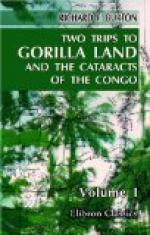At South Bay we came upon a grassy clearing larger than usual, near a bright stream; its pottery and charred wood showed the site of the Spanish barracoon destroyed by the British in 1840. During the last seven years the “patriarchal institution” has become extinct, and the old slavers who have at times touched at the island, have left it empty-handed. Corisco had long been celebrated for cam-wood, a hard and ponderous growth, yielding a better red than Brazil or Braziletto, alias Brazilete (Brasilettia, De Cand.) one of the Eucaesalpinieae, a congener of C. Echinata, which produces the Brazil-wood or Pernambuco-wood of commerce. In 1679, the Hollander Governor-General of Minas sent some forty whites to cultivate “Indian wheat and other sort of corn and plants of Guinea.” The design was to supply the Dutch West Indian Company’s ships with grain and vegetables, especially bananas, which grow admirably; I heard that there are fifteen varieties upon this dot of dry land. Thus the crews would not waste time and money at Cape Lopez and the Portuguese islands. The Dutch colonists began by setting up a factory in a turf redoubt, armed with iron guns, “the better to secure themselves from any surprise or assault of the few natives, who are a sort of wild and mischievous blacks.” The plantation was successful, but the bad climate and noxious gases from the newly turned ground, combined with over-exertion, soon killed some seventeen out of the forty; and the remainder, who also suffered from malignant distempers, razed their buildings and returned to the Gold Coast. When the Crown of Spain once more took possession of Fernando Po, it appointed a Governor for Corisco, but no establishment was maintained there. To its credit be it said, there was not much interference with the Protestant mission; public preaching was forbidden pro forma in 1860, but no notice was taken of “passive resistance.”




